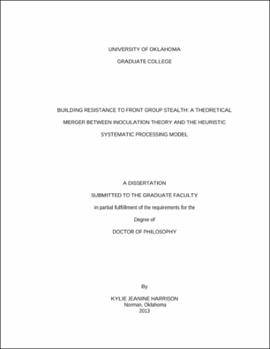| dc.description.abstract | This experimental research tested two motivational factors drawn from the heuristic processing model (Chaiken, 1980) to understand the role of message processing in the success of deceptive front groups. This research extended a series of applications of inoculation theory as a strategy to confer resistance to deceptive front group messages. Pfau et al. (2007) found inoculation produced resistance to front group attacks; however Robertson et al (2010) did not. Front groups often shift responsibility away from politicians or corporations, use vague arguments, and hide behind deceptive names. This research explored whether a standard inoculation message is sufficient to generate resistance to front groups' messages or if an improved inoculation treatment called RAN (responsibility/arguments/names) inoculation is necessary. Potential differences in information-seeking behaviors between the standard, RAN, and control group using Camtasia software were explored. Finally, it was anticipated that individuals who receive inoculation treatments are more accurate at classifying front groups than controls. Participants were 226 students from the Communication research pool at the University of Oklahoma. MANOVA, multiple regression, and Chi-Square tests were employed to test the research hypotheses. There were no differences between groups on the motivational variables or message processing, however the RAN treatments were superior to the standard inoculation treatments in that they produced more focused information-seeking behaviors. Overall, those in both inoculation conditions were more accurate at identifying front groups than controls. | |
